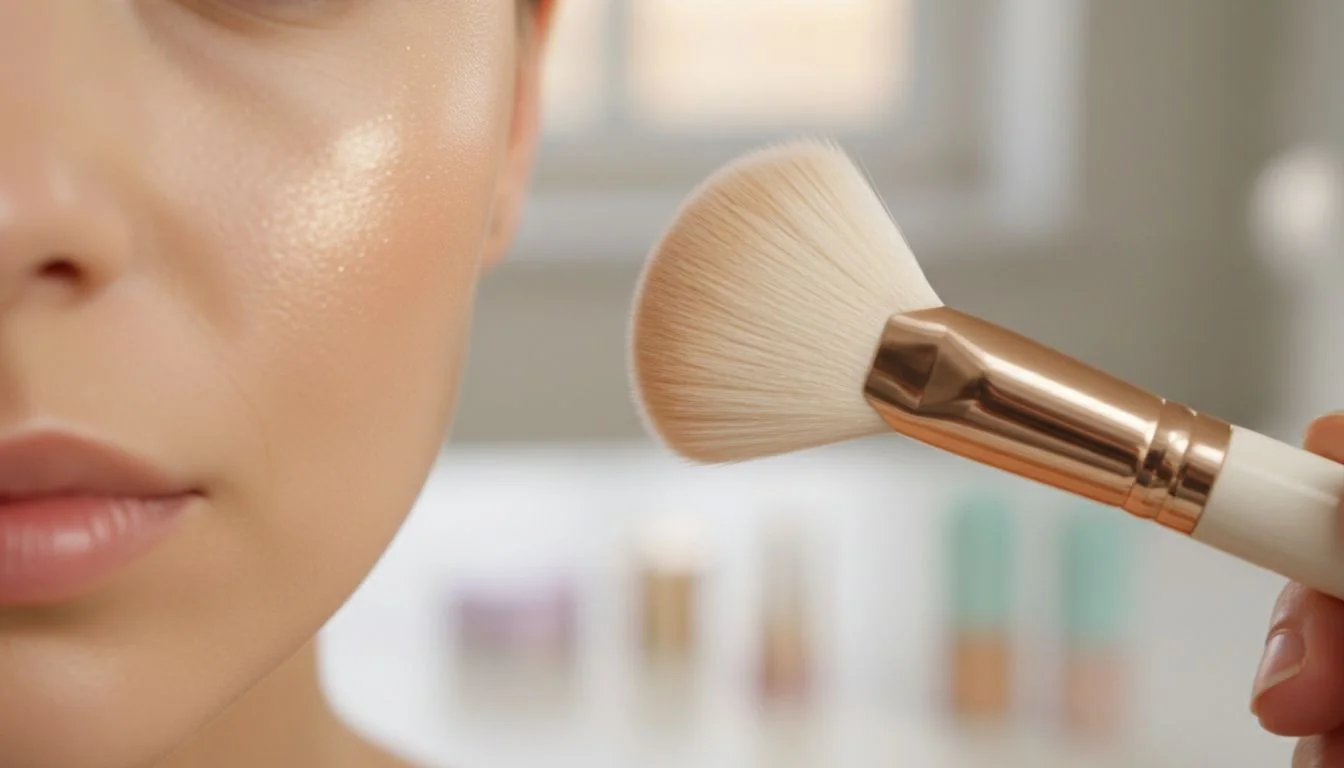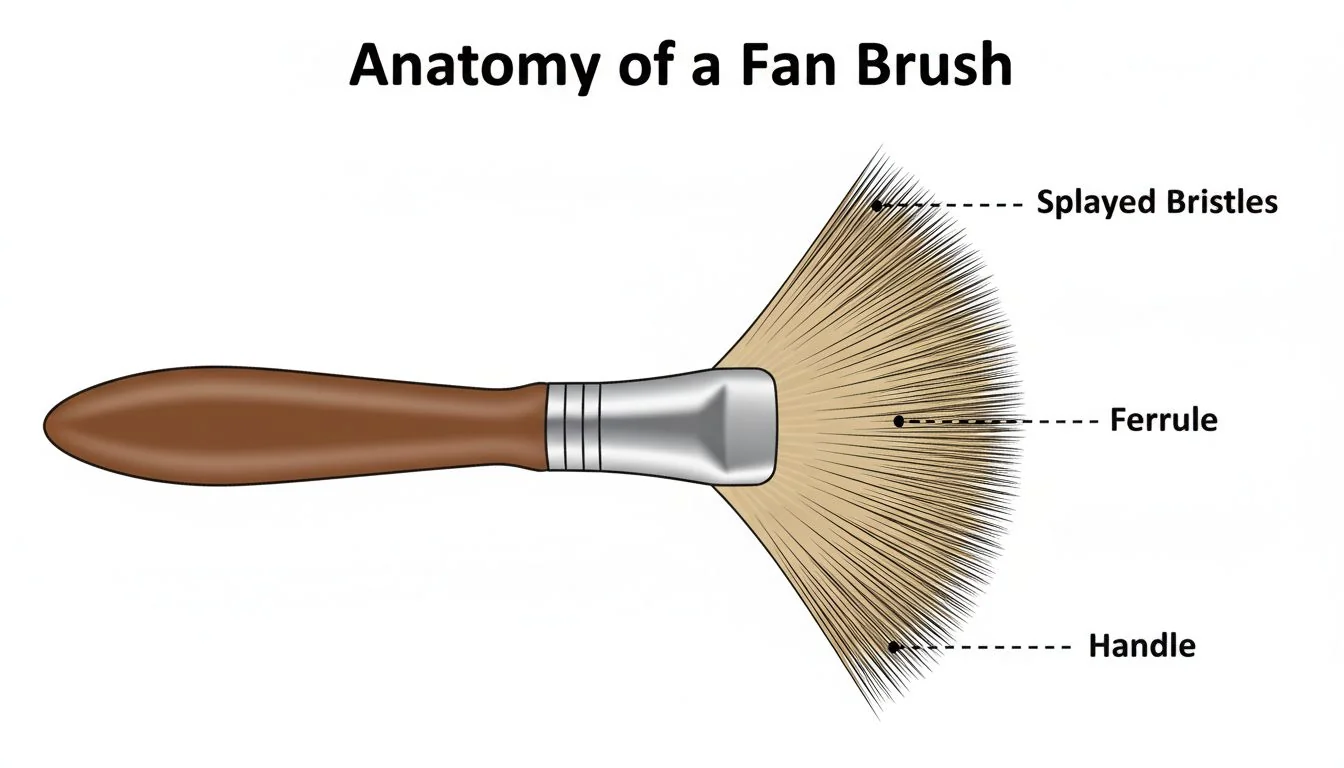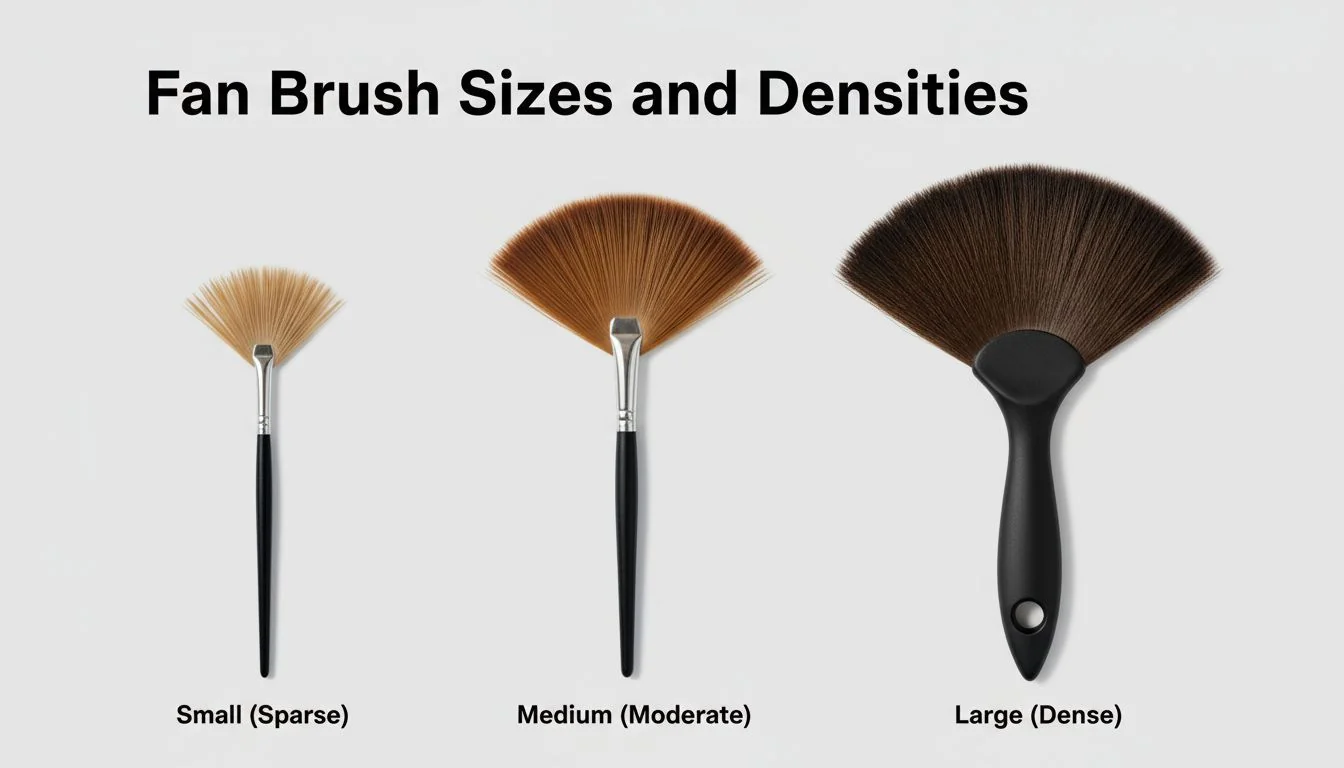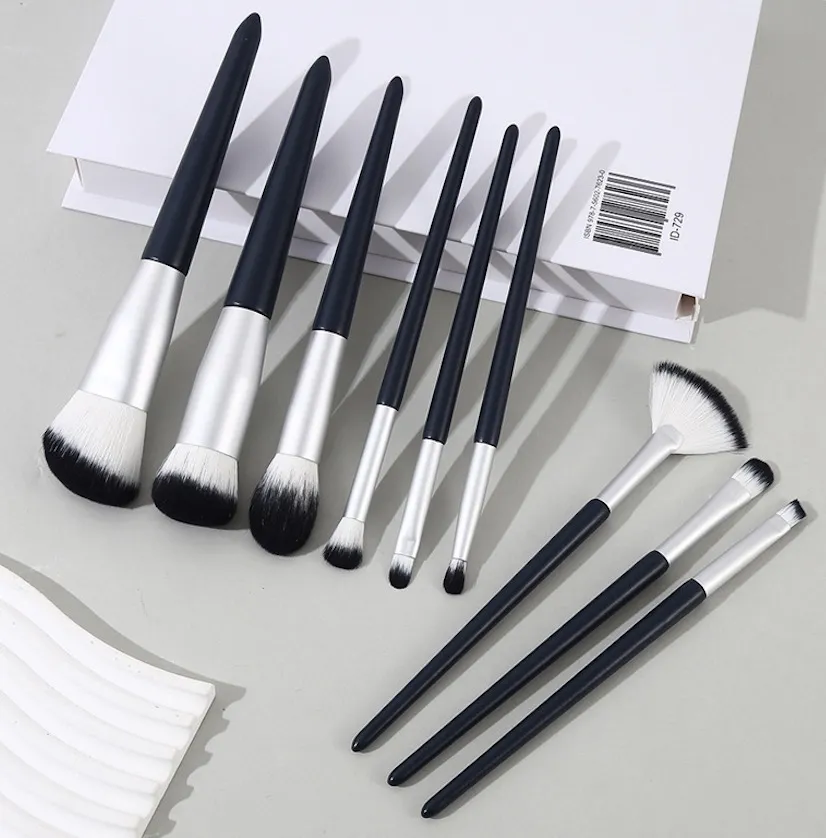Applying highlighter can be tricky. You want a beautiful glow, not a glittery stripe. The wrong brush easily over-applies product, undermining the quality look your brand promises.
A fan brush is a thin, fanned-out makeup brush designed to apply sheer, precise layers of powder—especially highlighter. It also sweeps away eyeshadow fallout to prevent cakiness and harsh lines. It’s ideal for a diffused glow on cheekbones, brow bones, and the nose bridge.

When I first started working on the factory floor, I saw thousands of brushes being made every day. I learned that the fan brush is one of the most misunderstood tools. Its unique shape isn’t just for looks; it’s engineered for a specific, delicate touch. For brand founders, understanding this design is key to sourcing a tool that delivers real performance for your customers. It’s the difference between a brush that gets used once and one that becomes a daily favorite. Let’s break down exactly what makes a fan brush a non-negotiable tool for any serious makeup line.
The global makeup tools market, including brushes, is projected to reach nearly USD 13 billion by 2034.True
Market analysis from various firms shows a consistent growth trend, with a CAGR of around 6.3%, reflecting rising consumer interest in high-quality beauty tools.
Fan brushes are a new invention, created only in the last decade.False
Fan brushes have been part of professional makeup artist kits for many decades, used for delicate powder application and cleanup long before the recent highlighting trend.
What Is a Fan Brush? Definition, Shape, and Core Use-Cases?
You see fan brushes in professional kits, but what do they actually do? Using the wrong tool can waste product and create a messy look, confusing your customers.
A fan brush has a flat, splayed profile designed for the lightest application of powder products. It’s your go-to for a soft-focus highlight or for gently dusting away eyeshadow fallout.

From a manufacturing perspective, the fan brush is all about precision engineering. The way the bristles are gathered in the ferrule and shaped determines its entire function. It’s not just a bunch of hairs glued to a stick. The goal is to create a tool that picks up minimal product and distributes it in a wide, sheer layer. This is why it excels at tasks where other brushes, like a dense powder brush, would be too heavy-handed. For your brand, marketing the fan brush should focus on this unique ability to deliver control and a flawless, natural finish.
The Anatomy of a Fan Brush
A fan brush is defined by its unique shape. It has a flat, wide silhouette with bristles that are spread out, or "splayed." This creates a very thin edge that is perfect for precise application. The density1 is typically low to medium, which prevents it from picking up too much powder.
Core Use-Cases for Your Brand
When you develop a fan brush, you should communicate its key functions clearly to your customers. This helps them understand its value.
| Use-Case | Description | Why a Fan Brush is Ideal |
|---|---|---|
| highlighter application2 | Applying powder highlighter to high points of the face. | The splayed shape deposits a sheer, diffused layer of shimmer, avoiding harsh, unnatural lines. |
| fallout removal3 | Sweeping away excess eyeshadow powder from under the eyes. | The light bristles remove powder particles without smudging or disturbing the foundation underneath. |
| sheer contouring4/Bronzing | Applying a very light layer of bronzer or contour powder. | It provides a subtle, sculpted effect that is hard to overdo, perfect for a natural look. |
| finishing powder5 | Dusting a light veil of setting powder over the entire face. | A large fan brush can apply a minimal amount of powder to set makeup without adding texture. |
A fan brush is the best tool for applying liquid foundation.False
Fan brushes are designed for powders. Their light, splayed bristles do not have the density or shape to blend liquid or cream products effectively, which would result in a streaky application.
The thin edge of a fan brush is perfect for creating a sharp contour line when used with powder.True
While it also diffuses product, a denser fan brush can be turned on its side to place a controlled, sharp line of contour powder before blending.
How to Choose a Fan Brush: Size, Density, Fiber, and Finish Control?
Sourcing a "fan brush" is too vague for a factory. The wrong specs lead to a brush that underperforms, resulting in customer complaints and hurting your brand’s reputation.
To choose the right fan brush, you must specify its size, density, and fiber type6. Small, low-density brushes are for a sheer glow. Larger, denser brushes give more payoff.

When a client like Emily sends me a request, the details are what matter. Saying "I need a fan brush" isn’t enough. I need to know the exact purpose to recommend the right specifications. Is it for a targeted inner-corner highlight or a broad sweep of bronzer on the décolleté? The answers determine the specs we build into the brush. Modern synthetic fibers are now my default recommendation. They offer incredible softness, are easy to clean, and align with the cruelty-free and vegan values that so many brands are building on. Let’s look at the specific choices you need to make.
A Manufacturer’s Guide to Fan Brush Specs
To ensure you get the exact brush your brand needs, you need to provide clear specifications to your manufacturer. Here is a table that breaks down the key variables and how they impact the final result.
| Specification | Low-Impact Option | Medium-Impact Option | High-Impact Option | Best For |
|---|---|---|---|---|
| Size (Head Width) | Small (20-35mm) | Medium (40-55mm) | Large (60mm+) | Small for detail (nose, brow bone). Medium for cheeks. Large for body/finishing. |
| Density | Low | Medium | High | Low for an ultra-sheer, diffused glow. High for more pigment payoff and sharper lines. |
| Fiber Type | Natural (Goat) | Standard Synthetic | Advanced Synthetic | Advanced synthetics offer the best softness, durability, and cruelty-free claims. |
| Edge Stiffness | Soft / Flexible | Medium | Stiff / Sharp | A softer edge gives a blended, airbrushed finish. A stiffer edge allows for more precise line work. |
All fan brushes are made with the same density.False
Fan brushes are manufactured in a wide range of densities. Low-density brushes are for sheer application, while high-density versions are made for more intense pigment payoff.
Modern synthetic fibers can outperform natural hair for powder application and are easier to maintain.True
Advances in synthetic filament technology have created fibers with textured surfaces that pick up and release powder effectively, while also being more durable, easier to clean, and cruelty-free.
Pro Kit Planning: When to Spec Fan Brushes vs. Highlight, Powder, or Kabuki?
Your brush collection feels redundant, or maybe it’s missing a key tool. Adding SKUs without a clear strategy hurts your profit margins and confuses your customers.
A fan brush is essential for a diffused glow and cleanup. For more intense highlight, use a tapered brush. For all-over buffing and coverage, use a powder or kabuki brush.

I often advise brand founders to think about their brush sets like a team. Each brush should have a specific job. You don’t need five brushes that all do the same thing. The fan brush is your specialist for delicate, precise work. It’s not your all-around powder brush, and it’s not your high-impact highlighter brush. For a direct-to-consumer brand, a single, well-designed medium fan brush might be enough. For a line targeting professional makeup artists, offering at least a small and a medium size is critical. This strategic approach to your product line prevents waste and ensures every brush you sell has a clear purpose.
Building a Cohesive Brush Set
Deciding which brushes to include in your line is a critical business decision. You want to offer a complete solution without creating unnecessary overlap. Here’s how the fan brush fits in with other common face brushes.
| Brush Type | Primary Use | Best Product Pairing | When to Choose It |
|---|---|---|---|
| Fan Brush | Sheer highlight, fallout cleanup | Powder highlighters, finishing powders | Choose it for a subtle, diffused glow and precision cleanup without disturbing base makeup. |
| Tapered Highlight Brush | Targeted, intense highlight | Powder & cream highlighters | Choose it when you want a focused, high-payoff glow on specific areas like the top of the cheekbones. |
| Fluffy Powder Brush | All-over powder application | Loose or pressed setting powders | Choose it for setting the entire face or applying a light dusting of bronzer over a large area. |
| Kabuki Brush | Buffing foundation, dense powder application | Mineral foundation, buffing powders | Choose it for building coverage and seamlessly blending products into the skin with a circular motion. |
A kabuki brush is the best tool for sweeping away eyeshadow fallout.False
A kabuki brush is far too dense. It would pick up the fallout and smudge it into the foundation, creating a mess. A light fan brush is the correct tool for this job.
For a professional makeup artist, having multiple sizes of fan brushes is beneficial.True
Pros need a small fan for detail work like the inner corner of the eye and a medium or large one for the face and body, making multiple sizes a necessity for a complete kit.
Quality, Care, and Longevity: Shedding Tests, Glue Integrity, and Cleaning Protocols?
Your samples looked perfect, but the bulk order has shedding brushes and loose handles. Poor quality control7 leads to customer returns and can permanently damage your brand’s reputation.
A quality brush must pass shedding tests and have a secure ferrule. To ensure longevity, clean brushes regularly with gentle soap and always dry them flat to protect the glue.

This is one of the biggest pain points I hear from brand founders. They receive a beautiful sample, but the final production run is a disaster. In my factory, we have strict quality control at every step. It’s not just about the final look; it’s about durability. We test for things that the end customer will experience, like shedding and how the brush holds up after washing. It’s also your job as a brand to educate your customers on proper care. Providing clear cleaning instructions not only helps the brush last longer but also positions your brand as a trusted expert.
QC Checkpoints I Use in My Factory
When you’re sourcing brushes, ask your manufacturer about their QC process. These are the non-negotiable tests we perform.
- The Tug Test: We gently pull on the bristles to ensure there is minimal to no shedding. A well-made brush should not lose its hairs.
- Ferrule Crimp Strength: The ferrule is the metal part that connects the handle to the bristles. We check that it is crimped tightly and securely, so the head doesn’t wobble or detach.
- Glue Integrity: We submerge the brush head in water and let it dry multiple times to simulate cleaning. This tests if the glue holding the bristles is strong enough to withstand regular use.
- Shape Uniformity: We inspect the fan shape to ensure the bristle cut is even and the splayed profile is consistent across the batch.
Educating Your Customer on Brush Care
Help your customers protect their investment with simple care instructions.
- Wash Weekly: Use a gentle soap or a dedicated brush cleanser with lukewarm water.
- Reshape: Gently squeeze out excess water and reshape the fan with your fingers.
- Dry Flat: Lay the brush flat on a clean towel to dry. Never dry it standing up, as water can seep into the ferrule and dissolve the glue over time.
You only need to clean your makeup brushes once a month.False
For hygiene and brush performance, brushes should be cleaned much more frequently. For personal use, once a week is recommended, and for professional use, after every client.
Drying brushes with the bristles pointing up can ruin them over time.True
When a brush is dried upright, water runs down into the ferrule, weakening the glue that holds the bristles. This leads to shedding and can cause the brush head to detach.
Conclusion
The fan brush is a specialist tool for a flawless finish. Understanding its design, quality checkpoints, and role in a brush set empowers you to source a superior product.
References
-
Learn how the density of a fan brush influences makeup application, ensuring the right amount of product is used. ↩
-
Discover expert techniques for applying highlighter flawlessly with a fan brush, ensuring a radiant glow without harsh lines. ↩
-
Learn how to use a fan brush to effortlessly sweep away eyeshadow fallout, keeping your makeup pristine and polished. ↩
-
Explore the advantages of using a fan brush for sheer contouring, achieving a natural look without overdoing it. ↩
-
Find out the best methods for applying finishing powder with a fan brush for a flawless, airbrushed finish. ↩
-
Understand the various fiber types in fan brushes and how they impact application and performance. ↩
-
Discover essential quality control measures to ensure your makeup brushes meet high standards and customer expectations. ↩


